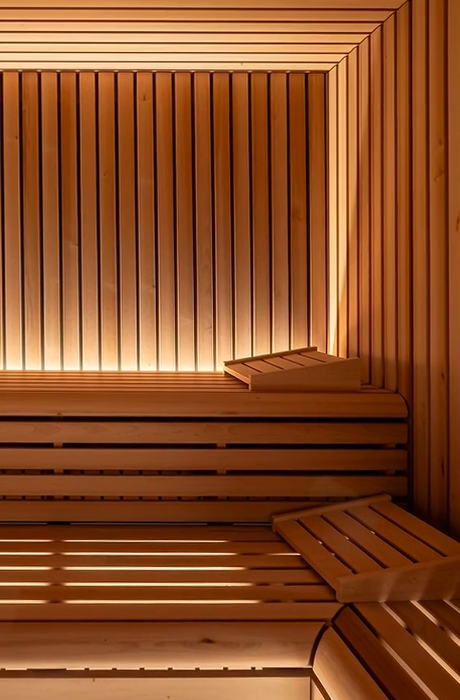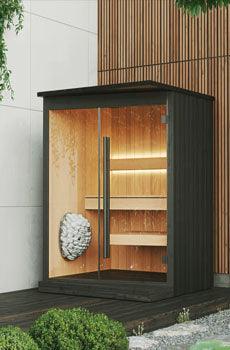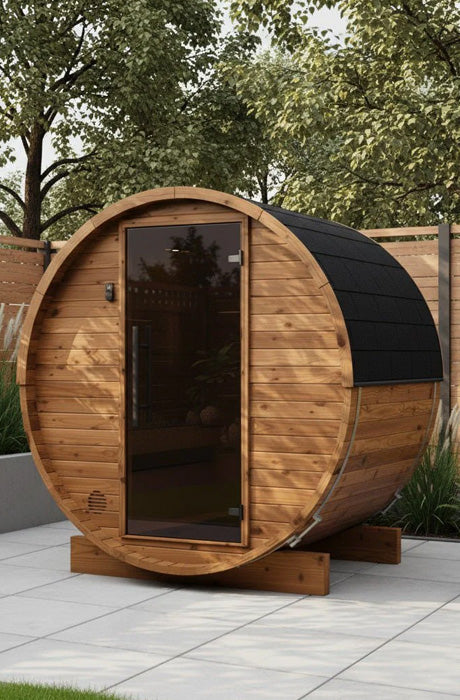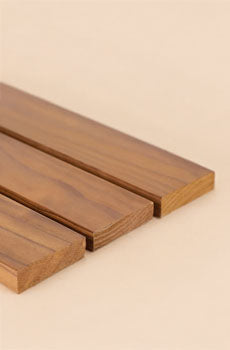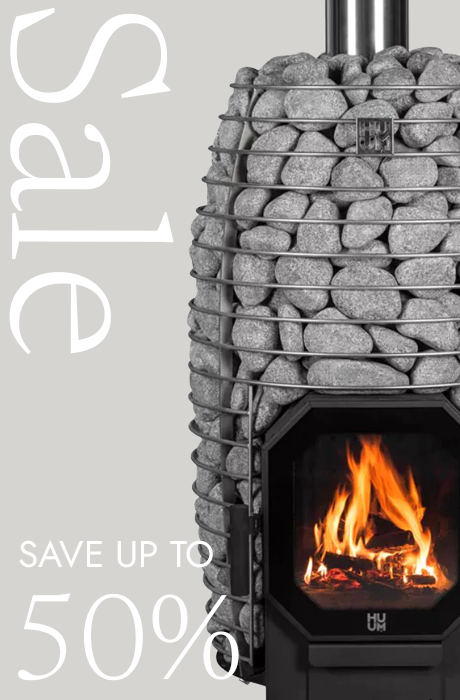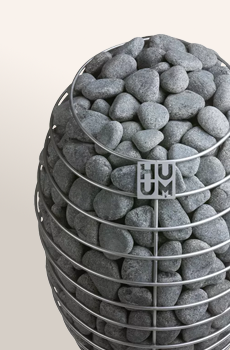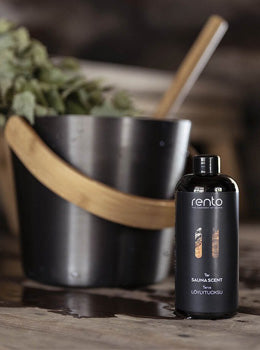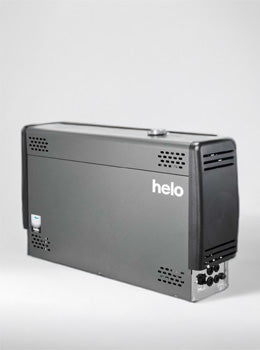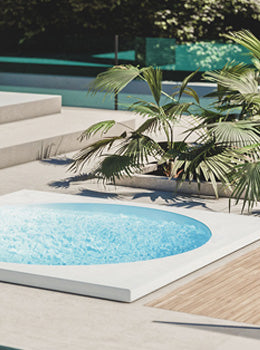How to Choose the Best Sauna Heater: A Complete Buyer’s Guide
Selecting the right sauna heater is essential for creating an authentic, enjoyable, safe and efficient sauna experience. Whether you’re seeking the rustic charm of a wood-burning heater or the convenience of a modern electric model with smart control options, this guide will help you navigate the key considerations, ensuring you choose a heater that aligns with your sauna’s specifications and your personal preferences.

Choosing the right sauna heater depends on the size of your sauna, the sauna's specifications, location and your personal preferences. Image provided by HUUM.
Determining the Appropriate Heater Size
Calculate Your Sauna’s Volume
Begin by calculating the volume of the sauna to determine the necessary output of your heater. Often, a rough guideline is that 1 kW of heater power is required for every 1 m³ of sauna volume. However, the power of your sauna heater must be matched to the internal computational volume of your sauna. This volume is not just the physical dimensions (length x width x height) - it also accounts for materials and design features that influence heat loss. This includes uninsulated surfaces, such as windows and glass sauna doors.
Volume Adjustments for:
-
Glass Surfaces: Add 1.5m³ for every 1m² of single glazed glass and 0.75m³ for every 1m² of double-glazed glass.
-
Uninsulated Walls: Add 1.5m³ for each square metre of other uninsulated surfaces.
These adjustments account for heat loss through materials that are less efficient at retaining heat.
Sauna Heater Calculator
Measure your sauna’s internal volume (length x width x height in metres) and add extra volume for glass and other uninsulated areas. Add 1.5m³ for every square metre of single-glazed glass. For double-glazed units, the volumetric factor is approximately 0.75.
An example calculation for a 2m x 2m x 2m sauna with a 2m x 2m x 2m double-glazed front window:
Sauna Volume: 2m x 2m x 2m= 8m³
Double-Glazed Glass Area: 2m x 2m= 4m²
Glass Adjustment: 4m² x 0.75m³= 3m³
Total Computational Volume of the Sauna: 8m³ + 3m³= 11m³
A slightly oversized heater is preferable to one that is underpowered, as you can moderate the output of a larger unit, but an underpowered unit will struggle to heat the space effectively. Selecting a heater that is too small for your space can lead to a range of issues that impact both performance and long-term costs. An underpowered heater will struggle to reach and maintain the desired temperature, resulting in extended heat-up times and a less enjoyable sauna experience overall.
When a heater is consistently pushed to its limits, the heating elements will struggle to operate at their capacity for prolonged periods. This continual strain can lead to premature wear and tear on critical components, particularly the heating elements, increasing the likelihood of breakdowns and costly repairs.
Additionally, an underpowered heater may fail to properly heat the sauna. This not only affects the ambient warmth but also compromises the quality of "löyly" (the burst of steam generated when water is poured onto the stones), which is central to an authentic sauna experience.
Choosing the correct heater capacity for your sauna is therefore critical - not only for optimal performance and energy efficiency but also to avoid unnecessary maintenance costs in the future.
Typical Power vs. Sauna Volume Guidelines:
|
Model Power Output |
4.5 kW |
6/6.8 kW |
9 kW |
10.5 kW |
|
Capacity of the sauna |
4-7m³ |
5–8/9 m³ |
8–14 m³ |
10–18 m³ |

Choose a sauna heater that is powerful enough for the size of your sauna. Uninsulated areas, such as windows, add to the internal computational volume of the space.
If unsure, speak to our experts to make sure you get it right the first time - Call +44 (0) 20 8050 2895.
Electric vs Wood-Burning Sauna Heaters
Choosing between electric and wood-burning sauna heaters depends on your desired experience, installation setting, and lifestyle. Electric heaters offer convenience, precise control, and are ideal for residential and urban settings, while wood-burning heaters deliver a traditional, off-grid experience with atmospheric charm.
There are several different types of wood burning and electric sauna heaters to choose from. In turn, infrared saunas use electromagnetic radiation from infrared lamps. In this article, we’ll be focusing on traditional sauna heaters. If you’re interested in the differences between infrared sauna and traditional sauna, you can read our article on the link below.
Infrared Sauna Benefits Vs Traditional Sauna Benefits- Which is best?
Electric Sauna Heaters
Electric sauna heaters are a popular choice for UK installations due to their ease of use, precise control, and minimal maintenance.
Key Advantages:
-
User-Friendly Operation: Simple startup and shutdown; programmable timers for scheduled use.
-
Flexible Control Options: Choose from built-in, external, or smart Wi-Fi controls for maximum flexibility.
-
Clean and Efficient: No flue or firewood required; ideal for indoor or residential settings.

Electric sauna heaters are popular in home saunas as they provide convenience and often smaller safety distances to combustible materials, allowing for installations in small spaces. Narvi Velvet electric sauna heater mounted into a floating bench system.
Understanding Electrical Requirements
Single-Phase vs. Three-Phase Power
In the UK, most residential properties have a 240V single-phase power supply. Heaters up to 9kW can typically operate on single-phase power, but it’s essential to verify compatibility, as there are exceptions to this. Heaters exceeding 9kW often require a 400V three-phase supply, which is more common in large commercial sauna builds.
Dedicated Electrical Circuits
Electric sauna heaters demand power and should be connected to dedicated circuits. Always refer to the heater installation manual and consult a qualified electrician to assess your home’s electrical capacity and to perform the installation safely.
You'll need the appropriate electrical components for installation. This typically includes an isolator switch, heat-resistant rubberised cable within the sauna, and armoured cable running back to your consumer unit. It's essential to discuss these requirements with a qualified electrician to ensure everything complies with safety regulations and operates reliably.
Finnmark offers a full range of electrical cables & isolators for saunas - fully compliant with UK regulations for reliable performance.
Control Units and Thermostats
Modern electric sauna heaters come with integrated control units and thermostats, allowing you to set and maintain desired temperatures and program heating schedules. Some models offer Wi-Fi connectivity, enabling remote control via smartphone apps. Ensure the control system is compatible with your heater and meets your usability preferences. Read more about how to choose the best controller for your sauna.

Many modern electric sauna heaters come with a variety of control options from manual dials to Wi-Fi control systems. UKU Wi-Fi glass black in the image.
Wood-Burning Sauna Heaters
For those seeking the traditional sauna experience, wood-burning heaters offer an unmatched atmosphere.
Key Considerations:
-
Authentic Feel: Crackling fire and soft steam recreate the true Finnish and Nordic sauna experience.
-
Off-Grid Friendly: No electricity required - ideal for rural and wilderness locations as well as zones that aren't smoke-free.
-
Installation Requirements: Must be fitted with a flue kit and may require additional heat shielding. We always advise consulting a HETAS-certified professional for a safe installation.
Maintenance & Operation:
-
Requires regular firewood loading and ash removal.
-
Flue and chimney should be inspected periodically for safe operation.
Special Features:
-
Tunnel Models: Allow external firewood loading, maintaining a clean sauna interior.
-
Water Tank Models: Heat water for washing, perfect for remote or off-grid use.

Wood-burning sauna heaters create a traditional experience accompanied with the relaxing crackling of firewood. IKI Original Wood-Burning sauna heater. Image by IKI.
Sauna Heater Installation Considerations
Safety Distances
Adhering to manufacturer-specified safety distances between the heater and combustible materials is vital to prevent fire hazards. These distances vary by model and installation type (wall-mounted vs. floor-standing). In most cases, wood-burning models require larger safety distances and additional heat shielding if installed in a smaller sauna.
Heater Placement
Strategic placement of the heater ensures even heat distribution:
-
Wall-Mounted Heaters: Ideal for smaller saunas to save space.
-
Floor-Standing Heaters: Suitable for larger saunas, offering higher outputs and options for mounting into the sauna benching.
Note: Always follow the manufacturer’s guidelines for installation and positioning.

It is important to consider features such as the minimum required safety distances to combustible materials when choosing your sauna heater. Tulikivi heaters have exceptionally small safety distances. Tulikivi Huurre in a Finnmark bespoke home sauna installation.
Design
There’s a rich variety of design options when it comes to both electric and wood burning sauna heaters.
Electric sauna heaters range from wall-mounted to floor standing, from pillar shapes to rounded structures, and from fully encased surfaces to visible sauna stones covered in a stainless-steel mesh. Some heaters can be easily mounted into the sauna benching, allowing for more space for the bathers.
When it comes to choosing the design of the sauna heater, it’s worthwhile to have a think about the overall sauna area. Where will the heater be placed, the location of the door and the layout of the benches. Some sauna users prefer the stones to be only visible at the top of the heater and others would rather choose a heater body made of a stainless-steel mesh, so you can throw water to the sides of the heater as well. This is completely up to your personal preference and the type of a sauna aesthetic you’re after.
Additional Features to Consider
-
Design Aesthetics: Choose a heater that complements your sauna’s interior, whether you prefer a traditional or contemporary style.
-
Stone Capacity & Quality: A higher stone capacity can provide a more consistent and gentle heat, enhancing the sauna experience. Choose high-quality olivine diabase or vulcanite sauna stones designed for sauna heaters. Pouring water over the stones is key to creating the iconic “löyly.” Both wood-burning and electric sauna heaters are designed to handle ladles of water throughout the sauna session.
-
Heat Shielding: You may want to consider heat shielding particularly for wood-burning sauna heaters to meet minimum safety distances to combustible materials.
-
Energy Efficiency: Opt for models designed to minimise energy consumption without compromising performance.
-
Warranty and Support: Consider the manufacturer’s warranty and the availability of customer support services.
Final Considerations When Choosing Your Sauna Heater
Assess Your Sauna’s Specific Needs: Consider size, insulation, uninsulated surfaces, electrics, and usage frequency.
Choose Your Heating Method: Decide between electric or wood-burning based on your lifestyle, installation context, and preferences.
Respect Safety Regulations: Always consult certified professionals (HETAS for wood, electricians for electric) for safe installation.
Consult Professionals: Engage qualified professionals, sauna specialists, and electricians for installation to ensure safety and compliance with UK regulations.
Prioritise Quality and Reliability: Invest in reputable brands known for durability and customer support. Finnmark only offers sauna heaters from market-leading Nordic brands, such as Narvi, HUUM, Helo, Tulikivi and IKI.

Prioritise quality and a choose a reputable brand that provides good customer support. Tulikivi XL electric sauna heater recognised for its soapstone cladding that retains heat and offers a unique design feature.
Finnmark’s Sauna Heater Range
We offer a carefully curated selection of premium sauna heaters - from elegant electric models to robust wood-burners - all backed with expert advice and UK-based customer service.
Helo: For Those Seeking Simplicity with Nordic Design
Founded over a 100 years ago, Helo is one of the first large heater manufacturers in the world. Helo factory is located in the Southern-Finnish port city of Hanko, where they produce a variety of reliable and cost-effective heaters for those who value simplicity in design. With a variety of models that have manual dials for controlling the heaters, Helo offers easy to work with options for all types of saunas.

Helo Rocher electric sauna heater is stylish floor standing model. Image by Helo
Maximum recommended run times for electric Helo heaters:
Domestic electric Helo heaters designed for private use should not be on for more than 6 hours at a time.
Commercial electric Helo heaters such as those in spas, swimming pools and gyms can be on around the clock as long as they are supervised. There should be at least one 6- hour period within 24 hours where the heater is switched off. This can be 6 hours straight or broken into 2-hour intervals. As an example: 3 x 2 hour off times within 24 hours.
HUUM: Where Style and Technology Meet
HUUM is a young Estonian sauna company, who have invested in a carefully designed selection of stylish and modern sauna heaters. The signature HUUM heaters feature a modern stainless-steel structure encasing a large amount of sauna stones. HUUM heaters have been recognised for their innovative designs and controlling options. Although the company does not have the same long-standing establishment in the sauna heater market as the majority of other heater suppliers, they are the “go-to" choice for the modern-day sauna user. The HUUM heaters will stand as a noticeable design feature in both commercial and home saunas.

HUUM Steel electric sauna heater is the perfect choice for a modern sauna. Image by HUUM
Narvi: An Excellent All-Rounder
Narvi is a Finnish sauna heater manufacturer, founded in 1937. All Narvi heaters bear the Finnish Key Flag Symbol indicating that they are designed and made in Finland, with 95% or more of the production within the country. Narvi heaters are an authentic, safe and quality product with a wide range of electric and wood burning heater options.
Narvi has a large variety of heater models to suit all budgets, functionality needs and design tastes.
 Narvi Smooth electric sauna heater can be also integrated into the benching. Image by Narvi
Narvi Smooth electric sauna heater can be also integrated into the benching. Image by Narvi
IKI: Where Durability is Paramount
IKI-Kiuas has been providing Finnish craftsmanship for sauna enthusiasts since the mid-nineties. The signature IKI heaters have a stainless-steel mesh frame alongside a substantial stone capacity, providing a uniquely effective, oxygen rich and soft steam experience. IKI has over 40 years’ experience in welding black iron and stainless- steel, and their heaters are one of the most durable in the market.
Although there isn’t a large variety of designs to choose from, the high-quality IKI heaters will last for years on years through heavy sauna use. An IKI heater is ideal for the hard-core “löyly” lovers.
Commercial or Domestic IKI Heater?
Any heaters from 12kW upwards do not have specific limitations when it comes to maximum run times. As such, even 12kW-15kW electric sauna heaters by IKI can be chosen for a commercial sauna. This is as long as the size of the sauna falls within the recommended capacities outlined by the supplier.
The IKI Pro heaters are specifically designed for large, commercial saunas.

Tulikivi: Leader in Quality and Experience
Tulikivi is known for high-quality, soapstone cladded sauna heaters and fireplaces. The exclusive soapstone is over 2 billion years old and carries heat storing capacities, wrapped in a beautiful look and feel.
Because of the natural qualities of soapstone, each Tulikivi product is unique with no heater looking exactly like the other. The heaters have minimal safety distances due to the soapstone cladding that will get hot but won’t burn you if you accidentally brush your skin on it. Tulikivi is a great heater choice in commercial saunas where safety is a concern, as well as in large family saunas used by young children.

Frequently Asked Questions
How do I calculate the right sauna heater size?
Measure your sauna’s internal volume (length x width x height in metres) and add extra volume for glass and other uninsulated areas. This is 1.5m³ for every square metre of single-glazed glass. For double-glazed units, the volumetric factor is approximately 0.75.
Once you have determined your sauna’s computational volume, have a look at heaters that you like the look of and check the instruction manual or technical specification for each available power rating and recommended sauna room volume.
What electrical supply do I need?
Sauna heaters must be hardwired by a qualified electrician to a dedicated electrical circuit. A standard plug socket is not suitable. Most UK homes have a single-phase 240V supply, which is sufficient for smaller heaters, often up to 9kW, with some exceptions (always check the heater-specific manual). Larger heaters, or those used in commercial or bigger sauna setups, may require a three-phase 400V supply.
What will it cost to run my electric sauna?
Heater running costs vary with size, frequency of use and how much your electricity provider charges for a single kW hour. For example, if you pay £0.34 per kW and have a 9kW heater, the heater will use 9kW x £0.34 during the first hour and roughly half thereafter. With thermostat cycling, a typical 1-hour session in this case would cost:
One hour to heat: 9kW x £0.34= £3.06
1 hour estimated using half of the power: £3.06/2= £1.53
Total run time cost: £3.06 + £1.53 = £4.59
You may want to include time to leave the heater on for about half an hour to help dry off the sauna, in which case, you would include the dry-off period in the above cost estimates.
Visit our full article on electric sauna heater running costs.
Can I install the heater myself?
No. In the UK, all sauna heater electrical connections must be carried out by a qualified electrician.
How should I position the heater and ventilation?
Check the heater’s minimum safety distances to combustible materials and clear the space around it, unless using suitable installation flanges or heat shielding. The ventilation air inlet should be near the heater, and an outlet vent below the benches on the opposite wall for optimal airflow. You may want to include an in-line extractor fan and a vent higher up in the ceiling or the wall to open after the sauna session.
What type of stones should I use, and how often should I replace them?
Use only stones that are specified for sauna heaters. These include olivine diabase or vulcanite sauna stones. You can add decorative stones to the very top of the heater once you have filled the heater body with olivine diabase or vulcanite stones. It is recommended that you inspect your stones 1-2 per year, depending on how often you use the sauna heater.
Read our full guide on sauna stones.
Can I pour water on electric heaters?
Yes, absolutely! This is what creates the steam or “löyly.” Pour one ladle at a time to enjoy the heat and steam. Don’t pour too much water at a time or before the sauna has fully reached temperature.
What maintenance does a sauna heater require?
-
Annual stone checking and replacement as needed
-
Regularly checking and cleaning dust or debris from around the heating elements. Please make sure to do this only when the heater hasn’t been used and is fully dry and cooled down.
-
For wood-burning sauna heaters, regular removal of ash and soot buildup from the firebox.
-
Inspecting the chimney and flue for blockages
-
Cleaning the flue
If you'd prefer to leave it to the experts, we offer a range of sauna servicing & maintenance packages.
How long do sauna heaters last?
This depends on the usage, but a well-maintained sauna heater can last 10-20 years.
Additional Resources
Learn about Sauna Heater Running Costs
Check How To Select, Inspect & Change Your Sauna Stones
Explore our full range of Electric Sauna Heaters
View our Wood- Burning Sauna Heaters
Get in touch with our sauna design consultants for additional advice on choosing the perfect sauna heater for your home or business.
Need help building your sauna? Check our step-by-step guide.





